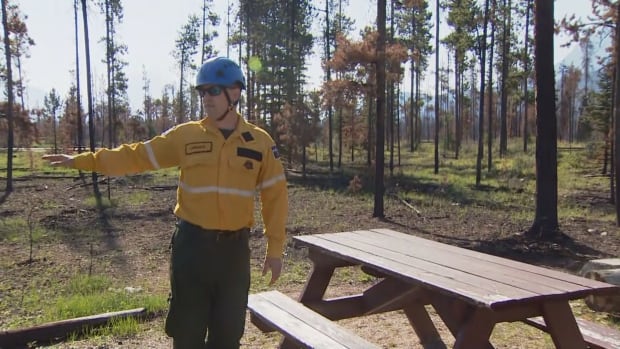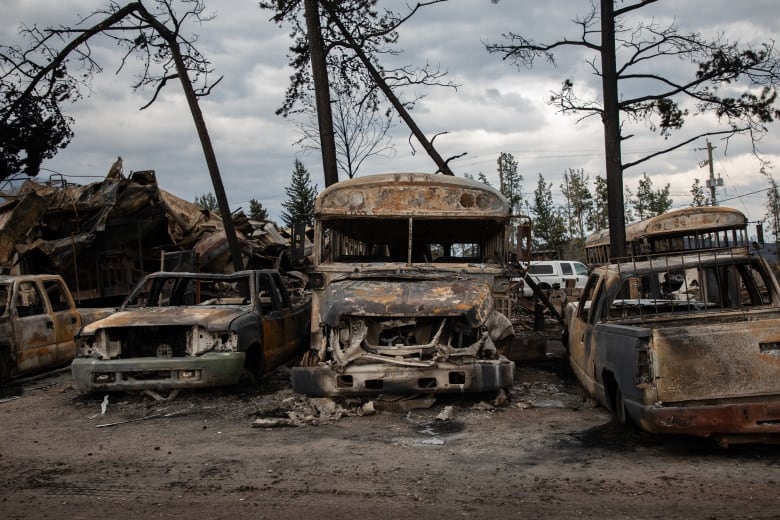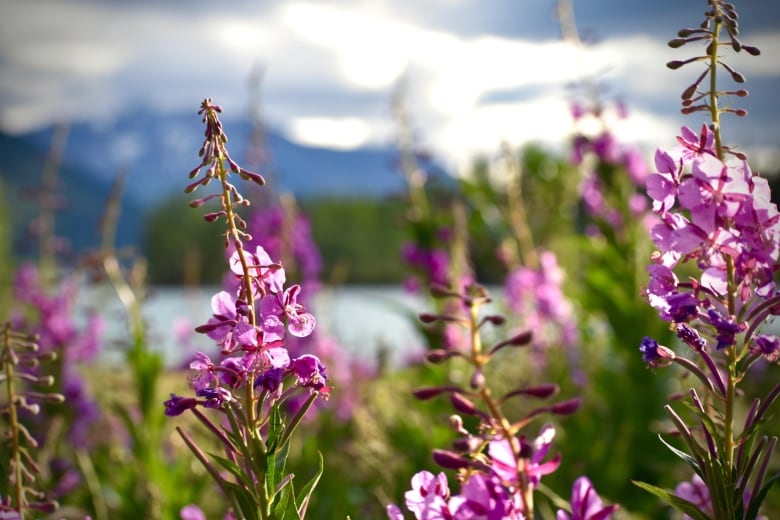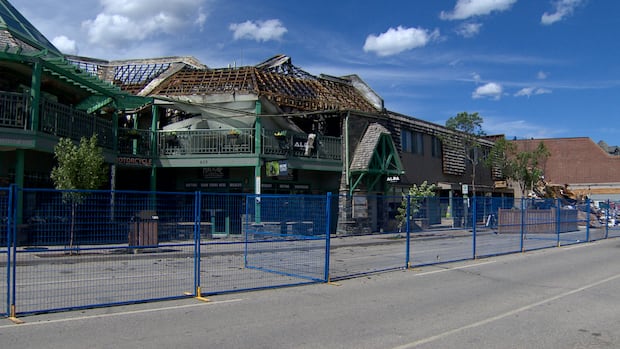
Landon Shepherd, sporting his yellow Parks Canada jacket and blue safety helmet, stood in a campground in Jasper National Park, beside a wooden pole with the metal remnants of a bear bin wrapped around it.
Patches of green grass were starting to sprout on the earth nearby, juxtaposed against a desolate landscape of fallen trees and others standing like burned matchsticks. The trees lining the mountainsides in the background were torched too.
“This was not green even a week ago; there were just a couple of odd plants. Since then, a bunch of things have sprouted up,” said Shepherd, a Parks Canada incident commander, while guiding a media tour through a couple of campgrounds on Sept. 7.
“In a month and a half, we’ve already got really good ground cover — even in a site that was stripped so severely as this.”
An immense wildfire — and the storm it created — swept through the national park nearly two months ago, burning accommodations, landmarks and attractions to various degrees. Eventually, the flames reached the Jasper townsite, destroying about one-third of its buildings.
Radio Active7:57Jasper balancing act: rebuilding the community and economy together
We speak to Tyler Riopel, the CEO of Tourism Jasper, about responsible tourism.
Recovery is ongoing, but visitors were recently allowed back into Jasper as well as several trails and day-use areas within the national park.
Locals are welcoming visitors with open arms, but experts suggest it is unclear how tourism will be affected due to a lack of research into how they respond to wildfires. The tourists who do go, they said, should prepare for the area to look different from its photos, as it may take years for the town to rebuild and decades for nature to heal.
The economy of Jasper, a town of roughly 5,000 people surrounded by the Rocky Mountains, relies heavily on tourism: Parks Canada annual reports show more than two million people visited Jasper National Park almost every year for the past decade — a fraction of whom are there for camping.
Before the COVID-19 pandemic, international tourists spent more than $1 billion on the Alberta side of the Rockies, Statistics Canada data shows. Spending in the region has yet to reach such levels since the pandemic, but international tourists still spent more than $500 million in 2022 — the last full year of data available.
“For those tourists who do go, know that you’re supporting a community in a time of need,” Michelle Rutty, an associate professor of geography and environmental management at the University of Waterloo in Ontario, told CBC News in an email.
“Your dollars spent will have a meaningful impact in terms of supporting Jasper in its efforts to recover and rebuild,” she wrote.
Tourist conduct
Jasper Mayor Richard Ireland has described re-opening to tourists as a delicate balance essential to the town’s recovery. Premier Danielle Smith, on her radio show last weekend, encouraged people to visit the town.
Residents were allowed home to start assessing their houses and businesses on Aug. 16, nearly four weeks after the evacuation order was issued. Some businesses are back in operation, while others may not be able to start up for a while yet.
Business owners recognize the challenging recovery ahead and need tourists’ help, recalling how hard it was for some to get by from the local population alone during the early days of the COVID-19 pandemic.
Government officials and some Jasper business owners are encouraging tourism, as the community has opened up to tourists again. Experts suggest it is unclear how a recent wildfire will affect tourism, but those who go should prepare for the area to look different from older photos.
Yet, there are limited accommodations because the town has to house residents whose homes burned down.
There is growing attention to wildfires and how they affect tourism. But there is little available research about how visitors perceive the risk and how they respond to such natural disasters, Rutty said. She noted that tourism was hampered last year in Kelowna, B.C., for example, due to wildfires — and the number of visitors hasn’t fully rebounded.
Some existing research suggests that, for various reasons, people are split about whether to visit a place after a natural disaster. Some are apprehensive because they want to be respectful, while others may be unaware — or want to go because — something happened there.
“You get this yin and yang,” said Lorri Krebs, a professor of geography and sustainability at Salem State University in Massachusetts.

Some people are looking for news and updates to understand what the community needs, while others — typically social media influencers and travel bloggers — may be going to get content, Krebs said.
Some tourists may also follow through with travel plans they made months ago, regardless of the fire, she added.
Jasper officials have encouraged visitors to practice responsible tourism. Krebs stressed that setting up codes of conduct for tourists will be “really, really important,” so people understand what is expected of them.
“We’ve seen that, with many other destinations, once something happens and the tourists that go there are going there because something has happened. That doesn’t mean that they are any better behaved,” Krebs said.
Other places in the Rockies, such as Banff, Alta., or places in B.C., will likely see an influx of tourists because people opt to skip Jasper, experts said. According to Rutty, travellers rarely opt to stay home.
Part of the challenge for Jasper, Rutty said, is to ensure providing accurate updates about the fire’s impact and fire risk, especially to attract international tourists.
International travellers are often more cautious, given the time and money they would be spending, she said. They may be unaware of the geography and could thusly be deterred by international news headlines about wildfire.
Not like the pictures
The Jasper Wildfire Complex, which was recently classified as under control, burned more than 33,300 hectares of the national park, scarring the landscape in a way that may be unrecognizable.
But wildfire is natural and Alberta’s forests know how to regrow from the ashes.
The roots of trembling aspen trees will regenerate trees when the visible parts are torched; pine cones, hanging from lodgepole pine trees, are glued together until fire melts the residue, releasing new seeds, said Brad Pinno, an associate professor at the University of Alberta’s renewable resources department.
“The trees that we’ve got, they really can respond incredibly quickly to fires,” Pinno said.
It could take decades before parts of the Jasper forest mature, he said, but the forest could become a functional ecosystem within the next 10 years or so.
In the meantime, Pinno said, tourists may be privy to witnessing the survival of the fittest between trembling aspen saplings.
On average, 1,000 aspen trees grow on a hectare of land, he said. But when they burn down, about 100,000 saplings vie for light and nutrients to replace those dead trees.
“They can start competing with their neighbours almost immediately,” he said. “What we see is, even within the first three years, there are tons of mortality of these trees”
Forest fires also invite different vegetation, even briefly, Pinno said. Next year, for example, tourists may spot a tall, pink wildfire colouring scorched areas: fireweed, as it’s called, thrives in areas affected by wildfire.

“The seeds will blow in from somewhere across the landscape,” Pinno said.
“We’ll have this crop of these beautiful pink flowers in some of these areas that have burned. Maybe it’ll stick around for a few years and then, eventually, they get shaded out.”
Various officials and academics have noted that climate change contributed to the Jasper wildfire in several ways. Rutty, of Waterloo, suggested the ongoing recovery is an opportunity to highlight how climate change affects people today — not in the future.
